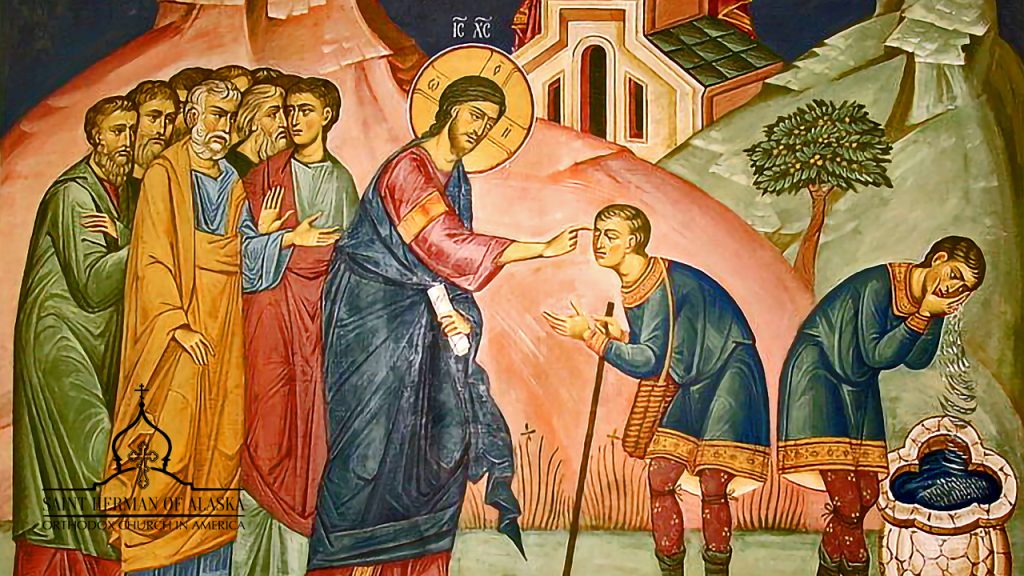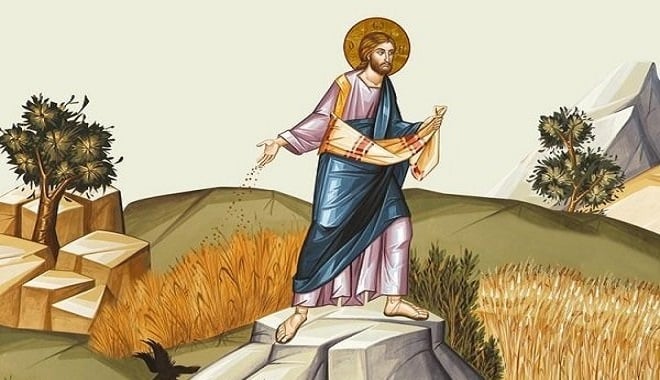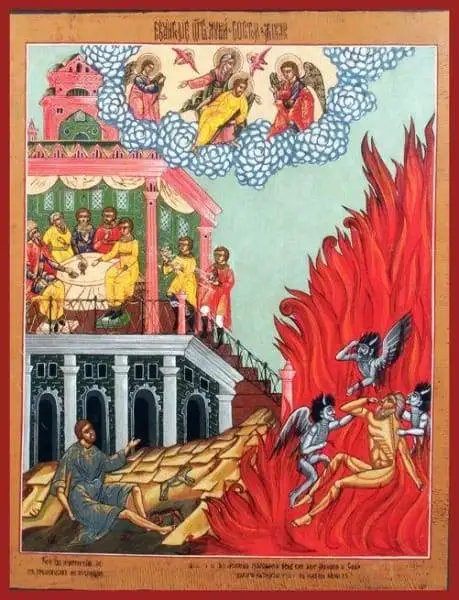
In the name of the Father, and of the Son, and of the Holy Spirit. Amen.
Christ is Risen! Truly He is Risen!
Beloved faithful, as we approach the culmination of the Paschal season, the Holy Church presents to us today the magnificent account of Christ healing the man born blind, as recorded in the ninth chapter of St John’s Gospel. This narrative stands as one of the most detailed miracle accounts in Scripture, revealing a miraculous restoration of sight but also a deeper unveiling of spiritual truth that transforms darkness into light.
The Evangelist begins: “Now as Jesus passed by, He saw a man who was blind from birth.” This detail, “from birth”, is crucial, for it eliminates any possibility that the man’s condition resulted from personal sin or negligence. His blindness was not acquired but inherent, making the subsequent healing even more extraordinary.
The disciples, reflecting the theological assumptions of their time, asked: “Rabbi, who sinned, this man or his parents, that he was born blind?” This question reveals humanity’s tendency to seek simple explanations for suffering, to assign blame and find causes that might make sense of life’s mysteries.
Christ’s response revolutionises our understanding of suffering: “Neither this man nor his parents sinned, but that the works of God should be revealed in him. I must work the works of Him who sent Me while it is day; the night is coming when no one can work. As long as I am in the world, I am the light of the world.”
The Lord then performs an extraordinary action. He spits on the ground, makes clay with the saliva, and anoints the man’s eyes. “Go,” He commands, “wash in the pool of Siloam” (which is translated, Sent). The man obeys, washes, and returns seeing.
What follows is a dramatic interrogation that reveals the spiritual blindness of those who claim to see. The Pharisees, disturbed that this healing occurred on the Sabbath, refuse to acknowledge the miracle. They question the man repeatedly, summon his parents, and ultimately excommunicate him from the synagogue for his testimony.
The healed man’s responses grow progressively bolder. Initially, he simply states, “A Man called Jesus made clay and anointed my eyes.” When pressed further, he declares, “He is a prophet.” Finally, confronted with their disbelief, he delivers a stinging rebuke: “Why, this is a marvellous thing, that you do not know where He is from; yet He has opened my eyes. Now we know that God does not hear sinners; but if anyone is a worshipper of God and does His will, He hears him. Since the world began it has been unheard of that anyone opened the eyes of one who was born blind. If this Man were not from God, He could do nothing.”
The Gospel concludes with Jesus finding the man after his excommunication. When Christ reveals Himself as the Son of God, the man responds with worship: “Lord, I believe.” Jesus then pronounces judgment: “For judgment I have come into this world, that those who do not see may see, and that those who see may be made blind.”
The Holy Fathers have recognised this Gospel as a treasure trove of spiritual wisdom, finding in it profound lessons about the nature of sin, grace, and spiritual perception.
St John Chrysostom emphasises the progressive nature of the man’s confession: “See how by degrees he ascended, first he called Him a man, then a prophet, then he believed Him to be from God, and last of all he worshipped Him as the Son of God.” The Golden-mouthed Father sees in this progression a model for catechetical instruction and spiritual growth.
St Cyril of Alexandria interprets the clay made from spittle as symbolising the original creation of Adam from the dust of the earth: “The Lord moistened clay and put it on the man’s eyes to show that the same hand that formed man from the beginning was now repairing what was lacking in human nature.” This connection links the healing to God’s creative and redemptive work throughout salvation history.
This Sunday concludes the post-Paschal Sundays before Ascension, serving as a bridge between the Resurrection and Christ’s return to the Father. The theme of illumination is particularly appropriate as we approach the feast of the Ascension, when Christ, the Light of the world, will withdraw His physical presence but promise the coming of the Spirit at Pentecost.
This Gospel narrative illuminates several fundamental theological truths that stand at the heart of Orthodox doctrine.
First, it reveals the relationship between physical and spiritual healing. While Christ could have simply spoken and restored sight, His use of clay and the command to wash in Siloam demonstrates that salvation involves both divine initiative and human cooperation. The man must act in faith, walking to the pool and washing as commanded.
Second, the progressive revelation of Christ’s identity, from “a Man called Jesus” to “a prophet” to “from God” to “Son of God”, mirrors the process of spiritual illumination. As St Gregory Palamas teaches, divine knowledge comes not through abstract reasoning but through purification, illumination, and theosis, that is, our union with God through grace. The man’s physical healing parallels his spiritual journey toward perfect recognition of Christ’s divinity.
Third, the narrative presents a profound theology of suffering. Christ’s response to the disciples’ question about the cause of blindness shifts focus from assigning blame to recognising divine purpose. This does not mean God causes suffering, but that He can bring good even from affliction, transforming it into an occasion for divine glory.
Fourth, the account demonstrates the distinction between mere religious knowledge and authentic spiritual perception. The Pharisees, learned in Scripture and zealous for the Law, are spiritually blind, unable to recognise the very Messiah they claim to await. Meanwhile, the uneducated beggar sees with clarity both physical and spiritual.
Fifth, the use of clay recalls the creation of Adam and points toward our recreation in Christ. As St Paul writes, “If anyone is in Christ, he is a new creation; old things have passed away; behold, all things have become new” (2 Corinthians 5:17). The healing becomes a type of the new creation that comes through baptism and the Christian life.
Sixth, the pool of Siloam, meaning “Sent”, connects to the entire economy of salvation. Christ, the Sent One from the Father, sends the man to be healed in waters that prefigure baptism. This sending continues in the Church’s mission to the world, as we who have received sight are sent to open the eyes of others.
The disciples’ question about the cause of blindness reflects our own tendency to seek explanations for suffering rather than opportunities for grace. When faced with trials such as illness, loss, or disappointment, we often ask “Why me?” or “What did I do to deserve this?” Christ redirects such questions toward divine purpose, asking instead how God’s works might be revealed through our circumstances.
The Lord’s method of healing instructs us about the nature of spiritual transformation. He could have healed instantaneously, yet He chose to use clay and require the man’s active participation. Similarly, our spiritual healing involves both divine grace and human cooperation. We must “wash in the pool of Siloam”, that is, submit to the sacraments, practise the disciplines of prayer and fasting, and live according to Christ’s commandments.
The progressive nature of the man’s confession mirrors our own spiritual development. We may begin with simple recognition, “a Man called Jesus”, and gradually grow toward fuller understanding and worship. This process requires patience with ourselves and with others who may be at different stages of spiritual growth.
The opposition the man faced after his healing warns us that authentic Christian witness may bring persecution. Speaking truth about Christ’s identity and works can result in exclusion from family, friends, or society. Yet like the healed man, we must choose between human approval and divine truth.
The contrast between the healed man and the Pharisees challenges us to examine our own spiritual sight. Do we, like the Pharisees, claim to see while remaining blind to God’s works? Do our religious observances enhance or hinder our perception of Christ’s presence? Are we more concerned with protecting our religious systems than recognising divine truth?
The man’s final confession, “Lord, I believe”, and his act of worship point us toward the ultimate purpose of spiritual healing. It is not merely to see, but to worship the One who gives sight. Every grace we receive, every moment of illumination, every healing of body or soul should lead us to deeper adoration of Christ.
As we prepare for Ascension, when Christ will withdraw His visible presence, this Gospel assures us that He continues to heal the blind. Through the Church’s sacraments, especially baptism and chrismation, spiritual sight is granted to those born in darkness. Through the Divine Liturgy, our inner eyes are continually opened to perceive the mystery of salvation.
Christ is Risen! Truly He is Risen!
Copyright © 2025 The Rev. Adrian Augustus. The Russian Orthodox Church of the Archangel Michael, Blacktown, NSW


